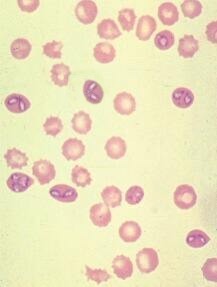
Babesia sp. is a protozoan parasite that affects many species and can cause hemolytic anemia following the infection of red blood cells. Ticks are responsible for the transmission of the parasite. Babesia sp. organisms are species specific and therefore not transmissible from one species to another. In cattle, babesiosis can be caused by Babesia bigemina, Babesia bovis, Babesia major and Babesia divergens. Babesia bigemina and Babesia bovis are the two species of economic importance. In sheep and goats, Babesia ovis and Babesia motasi are the agents of importance, as are Babesia equi and Babesia caballi in equines. Finally, the species of importance in small animals are Babesia canis and Babesia gibsonii in dogs, and Babesia felis in cats.
In this microscopic field, note that many erythrocytes are affected. The appearance of the parasite is variable, but most often tear shaped. The parasite reproduces by binary fission, such that two or more parasites can be present in one red blood cell. Reproduction causes the lysis of the red blood cells and liberation of the parasite. Note that contrary to Haemobartonella sp. and Eperythrozoon sp., Babesia sp. is an intra-erythrocytic parasite. The observation of the parasite within red blood cells is necessary for the diagnosis of babesiosis, but serological tests can be used to identify carriers.